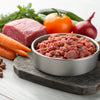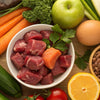Can I Feed My Dog Raw and Cooked Food? Exploring the Best Nutritional Approach for Your Canine Companion
- Houndsy
Table of Contents
- Introduction
- Understanding Canine Nutrition
- The Raw Diet Philosophy
- Cooked Food for Dogs
- Can You Mix Raw and Cooked Food?
- Understanding Your Dog's Preferences and Needs
- Conclusion
Introduction
Have you ever questioned whether the diet you’re providing for your dog is truly the best for their well-being? The relationship between diet and a dog’s health is a topic that has generated much buzz within the pet owner community. In fact, studies show that around 65% of dog parents are exploring various feeding options, including both raw and cooked foods. With the ongoing debate surrounding raw diets promising benefits like shinier coats and healthier digestion, it’s vital we dig deeper into the implications of mixing raw and cooked foods.
In this blog post, we aim to unravel the complexities of canine nutrition and explore whether you can safely combine raw and cooked meals. We will discuss the advantages and potential risks associated with both dietary approaches while offering insights into how to create a balanced feeding routine that supports your dog’s health. By the end of this article, you will understand the nuances of canine nutrition and have the confidence to design a diet that’s optimal for your furry friend.
Join us on this journey as we tackle the question: "Can I feed my dog raw and cooked food?" and help you reflect on your own pet-feeding strategies.
Understanding Canine Nutrition
Before we dive into the debate surrounding raw and cooked diets, it's essential to grasp the basics of canine nutrition. Dogs are omnivores, meaning their dietary needs include a mix of proteins, fats, carbohydrates, vitamins, and minerals.
The Need for Nutritional Balance
Nutritious diets play a crucial role in your dog’s overall health, energy levels, and longevity. Just as with humans, dogs require a diet that meets their nutritional requirements for growth, maintenance, and reproduction. A well-balanced diet typically includes ingredients like:
- Proteins: For growth, repair, and energy.
- Fats: Important for energy and supporting cellular functions.
- Carbohydrates: Provide energy and promote a healthy digestive system.
- Vitamins and Minerals: Essential for numerous biological functions.
Understanding these components is vital for evaluating the merits and concerns of both raw and cooked feeding practices.
The Raw Diet Philosophy
The raw dog food movement, often referred to as "BARF" (Biologically Appropriate Raw Food), is based on the premise that feeding dogs raw animal parts emulates their natural ancestral diet. This includes a variety of meats, bones, organs, and sometimes fruits and vegetables.
Benefits of a Raw Diet
- Natural Ingredients: Proponents argue that raw food diets offer unprocessed nutrients without fillers or additives.
- Improved Digestion: Raw diets are believed to improve digestion through high levels of natural enzymes.
- Dental Health: Chewing on raw bones can help maintain dental hygiene by reducing plaque buildup.
- Increased Energy Levels: Many dog owners report their pets displaying heightened energy levels after transitioning to a raw diet.
These benefits are compelling. However, it’s crucial to consider the whole picture, including potential downsides.
Risks of a Raw Diet
- Bacterial Contamination: Raw meat can harbor harmful bacteria like Salmonella and E. coli, posing a risk to both dogs and humans.
- Nutritional Imbalances: A poorly formulated raw diet can lead to vitamin and mineral deficiencies or excesses, risking your dog’s overall health.
- Parasites: Raw meat can also contain unwanted parasites which may compromise your dog's health.
- Hazardous Bones: While some bones are safe, others can splinter and cause choking or internal injuries.
Given these considerations, it’s essential to approach a raw diet with caution and proper knowledge.
Cooked Food for Dogs
On the other end of the spectrum, cooked dog food has been a staple in pet nutrition, offering a practical and safer alternative to raw feeding. Cooked foods include kibble, canned, or home-cooked meals prepared with ingredients that are often recognizable and typically safer.
Benefits of Cooked Food
- Safety First: The cooking process kills harmful pathogens, greatly reducing the risk of foodborne illnesses.
- Digestibility: Cooking breaks down proteins, making them easier for dogs to digest.
- Customizable: Pet owners can modify and tailor cooked meals to meet specific dietary needs, whether it's for allergies or health conditions.
- Convenience: Prepared dog foods can be more convenient for owners who aren’t able to prepare raw meals safely.
Potential Downsides
- Nutrient Degradation: Some nutrients, particularly water-soluble vitamins like B vitamins, can be lost during cooking.
- Lack of Enzymes: Cooking destroys many natural digestive enzymes that would help with digestion.
- Additives: Not all commercial cooked foods are created equal; some may contain preservatives or fillers.
Given these insights, it becomes apparent that both raw and cooked diets have their merits and pitfalls.
Can You Mix Raw and Cooked Food?
The question arises: "Can I feed my dog raw and cooked food?" The short answer is yes, you can mix raw and cooked foods, but there are some vital considerations to keep in mind.
Benefits of Combining Both Diets
- Nutritional Diversity: Mixing raw and cooked foods can provide a balanced array of nutrients and textures.
- Enhanced Palatability: Many dogs enjoy the variety offered by blending both types of food.
- Health Management: By combining both diets, you can tailor the nutrition based on your dog's specific health needs or preferences.
Guidelines for Mixing Raw and Cooked
To achieve a harmonious blend, consider the following guidelines:
- Consult Your Veterinarian: Before making any dietary changes, seek advice from your vet, especially if your dog has health issues.
- Monitor Digestive Responses: Gradually introduce new foods and watch for any digestive upsets. Every dog has unique tolerances.
- Avoid Cross-Contamination: Prepare raw and cooked meals using separate utensils and areas to minimize the risk of bacterial growth.
- Layering Meals: Serve raw and cooked foods at separate times rather than mixing them together in one meal. This can help avoid digestive distress because raw and cooked foods digest at different rates.
Understanding Your Dog's Preferences and Needs
Every dog is unique, and their individual needs and preferences play a significant role in determining the best diet.
Recognizing Your Dog's Signals
Dogs can communicate their dietary preferences through their behavior. Pay attention to:
- Energy Levels: Notice changes in activity levels when introducing new foods.
- Body Condition: Regularly check your dog's weight and overall condition for signs of either weight gain or loss.
- Coat Health: Monitor changes in the coat condition for indicators of nutritional deficiencies or surpluses.
Adapting to Changes
As with any dietary transition, gradual changes are essential. Mix foods over several days or weeks, giving your dog’s digestive system time to adjust and helping to avoid gastrointestinal upset.
Conclusion
In conclusion, it is possible to create a balanced and healthy diet for your dog by mixing raw and cooked foods. By understanding the benefits and risks of each approach, we can better appreciate how to support our furry friends’ well-being.
Ultimately, remember that every dog is different. Ongoing observation and consultation with your veterinarian will provide the best path toward optimal nutrition. Would you consider introducing a variety of meals into your dog's routine? Perhaps even incorporating a bit of the stylish and convenient Houndsy Kibble Dispenser to simplify your feeding process? Order Now.
Your commitment to understanding your dog’s dietary needs is already a step in the right direction, so keep experimenting wisely and providing the love they deserve!
FAQ
1. Can I feed my dog both raw and cooked food together in one meal?
While it’s not advisable to mix raw and cooked foods in a single meal, you can serve them at different times. This helps ensure proper digestion.
2. Is it safe to prepare raw dog food at home?
Homemade raw diets can be challenging to balance nutritionally and may pose safety risks due to bacterial contamination. Consultation with a veterinary nutritionist is highly recommended.
3. What are the signs that my dog is not tolerating raw food?
Signs may include vomiting, diarrhea, or changes in appetite. If you observe these symptoms, consult your veterinarian immediately.
4. Is it necessary to introduce supplements when feeding my dog a raw diet?
Yes, a raw diet may lack essential vitamins and minerals. It is critical to supplement and ensure nutritional balance to avoid deficiencies.
5. How can I transition my dog to a new diet safely?
Gradually introduce new foods over 7-10 days, mixing small amounts with their current food until fully transitioned. Monitor for any adverse reactions throughout the process.
By approaching your dog’s diet thoughtfully and incorporating the principles we’ve discussed today, you can nourish their body and support their overall happiness.













